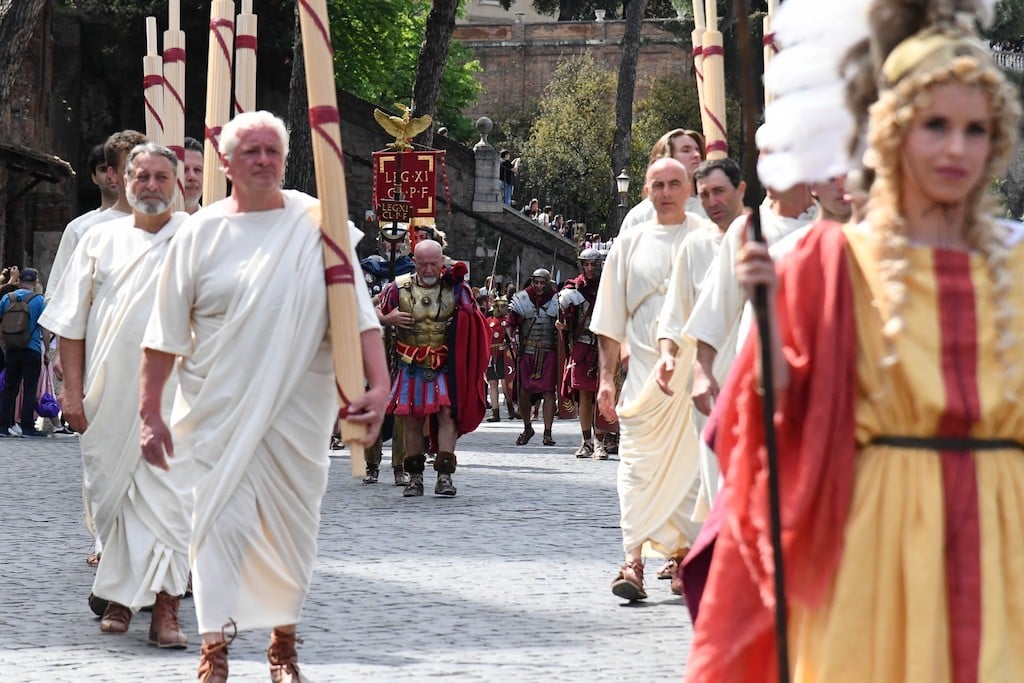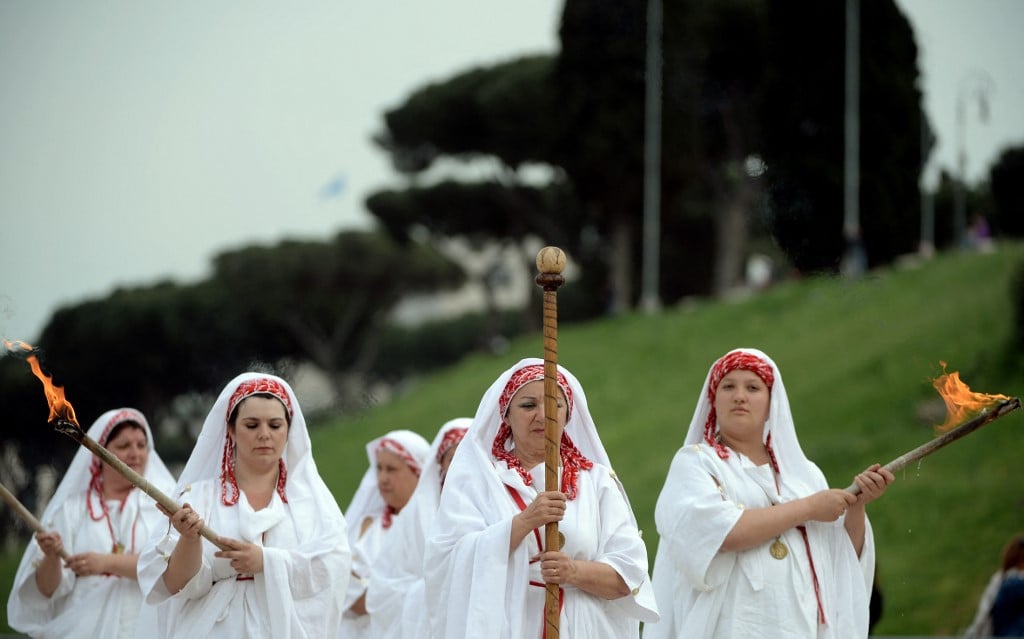Why Rome celebrates its birthday on April 21st

Rome will turn 2,777 years old on April 21st – but what's the history behind the Eternal City's birthday?
Italy's capital celebrates the anniversary of its founding on April 21st every year – a very specific date for an event surrounded by mystery.
The stories we have about Rome's birth come from Ancient Romans, who were hardly the most reliable sources: they weren't interested in documenting the mundane process of how settlements develop over time, but wanted to tie their city to gods, fate and myths to bolster its standing as Caput Mundi, head of the Roman Empire and rightful 'capital of the world'.
The legend goes that Aeneas, son of the goddess Aphrodite and prince of the doomed Greek city of Troy, led the survivors of the Trojan War across the Mediterranean and all the way to the Italian peninsula.
Having been guided by gods and destiny to the southwest coast, the hero fought a rival king and married a local princess, winning the right for the Trojans and their descendants to settle.
Two of these descendants were Romulus and Remus, the twin brothers abandoned by the River Tiber because the reigning king feared they might one day challenge him for the throne. The boys survived thanks to a she-wolf who nursed them and a shepherd who took them in, before growing into brave fighters with ambitions to found a city of their own.
Myth has it that the brothers couldn't agree on which hill should be the starting ground: the Palatine Hill, preferred by Romulus, or the Aventine Hill wanted by Remus.

View of a historical parade held to celebrate Rome's birthday on April 21st 2023. Photo by STRINGER / AFP
The brothers put the question to the gods, each seeking an omen that would prove they were right: Remus claimed he saw six auspicious birds fly over his hill, while Romulus topped him by saying he had seen 12.
Each twin continued to insist he was right, and Romulus began drawing up the limits of the new city. When Remus crossed the boundary he had etched on the ground, his brother (or one of his henchmen) was so angered he killed him.
Romulus would go on to found Rome on the Palatine Hill, becoming its first king and its namesake.
While historians dispute almost every element of this story, that's the version that Ancient Romans told about their city.
They also pinned the events to a specific day: April 21st, which is the date named by the Roman poet Ovid in his 'Book of Days' (Fasti), a literary account of the origins of various Roman festivals throughout the year.

Women dressed as Roman Vestals perform a ceremony to mark Rome's birthday. Photo by FILIPPO MONTEFORTE / AFP
It seems that Roman emperors co-opted an earlier agricultural festival traditionally held on April 21st, which saw shepherds symbolically 'purify' their sheep in honour of the god of livestock, Pales. Known as the Parilia, the ritual saw shepherds pray for forgiveness for any accidental offences they and their flock might have given the god, such as trespassing on sacred ground, then make offerings and finally leap through the cleansing flames of a sacred bonfire.
READ ALSO: The ancient Roman foods Italians still eat
As Rome grew into a metropolis, its rulers repurposed the Parilia and turned it into a celebration of Rome's legendary origins as a way of uniting Romans behind the city's old and new identities. Julius Caesar introduced games; Caligula added a procession of the city's great and good.
Over the years, April 21st went from a farming festival to the imposing dies natalis Romae, or 'birthday of Rome'.
As for the year of Rome's birth, ancient historians pegged it as 753 BC (though archaeologists have found traces of much older settlements on the Palatine Hill and surrounding areas).
Writing in the 1st century BC, Marcus Terentius Varro identified this date from the records available and set it as the starting point of Roman chronology: years were subsequently measured ab urbe condita, or 'from the founding of the city', making 753 BC the year AUC 1.
That timeline will make Rome 2,777 years old on Sunday, April 21st.
Comments (1)
See Also
Italy's capital celebrates the anniversary of its founding on April 21st every year – a very specific date for an event surrounded by mystery.
The stories we have about Rome's birth come from Ancient Romans, who were hardly the most reliable sources: they weren't interested in documenting the mundane process of how settlements develop over time, but wanted to tie their city to gods, fate and myths to bolster its standing as Caput Mundi, head of the Roman Empire and rightful 'capital of the world'.
The legend goes that Aeneas, son of the goddess Aphrodite and prince of the doomed Greek city of Troy, led the survivors of the Trojan War across the Mediterranean and all the way to the Italian peninsula.
Having been guided by gods and destiny to the southwest coast, the hero fought a rival king and married a local princess, winning the right for the Trojans and their descendants to settle.
Two of these descendants were Romulus and Remus, the twin brothers abandoned by the River Tiber because the reigning king feared they might one day challenge him for the throne. The boys survived thanks to a she-wolf who nursed them and a shepherd who took them in, before growing into brave fighters with ambitions to found a city of their own.
Myth has it that the brothers couldn't agree on which hill should be the starting ground: the Palatine Hill, preferred by Romulus, or the Aventine Hill wanted by Remus.

The brothers put the question to the gods, each seeking an omen that would prove they were right: Remus claimed he saw six auspicious birds fly over his hill, while Romulus topped him by saying he had seen 12.
Each twin continued to insist he was right, and Romulus began drawing up the limits of the new city. When Remus crossed the boundary he had etched on the ground, his brother (or one of his henchmen) was so angered he killed him.
Romulus would go on to found Rome on the Palatine Hill, becoming its first king and its namesake.
While historians dispute almost every element of this story, that's the version that Ancient Romans told about their city.
They also pinned the events to a specific day: April 21st, which is the date named by the Roman poet Ovid in his 'Book of Days' (Fasti), a literary account of the origins of various Roman festivals throughout the year.

It seems that Roman emperors co-opted an earlier agricultural festival traditionally held on April 21st, which saw shepherds symbolically 'purify' their sheep in honour of the god of livestock, Pales. Known as the Parilia, the ritual saw shepherds pray for forgiveness for any accidental offences they and their flock might have given the god, such as trespassing on sacred ground, then make offerings and finally leap through the cleansing flames of a sacred bonfire.
READ ALSO: The ancient Roman foods Italians still eat
As Rome grew into a metropolis, its rulers repurposed the Parilia and turned it into a celebration of Rome's legendary origins as a way of uniting Romans behind the city's old and new identities. Julius Caesar introduced games; Caligula added a procession of the city's great and good.
Over the years, April 21st went from a farming festival to the imposing dies natalis Romae, or 'birthday of Rome'.
As for the year of Rome's birth, ancient historians pegged it as 753 BC (though archaeologists have found traces of much older settlements on the Palatine Hill and surrounding areas).
Writing in the 1st century BC, Marcus Terentius Varro identified this date from the records available and set it as the starting point of Roman chronology: years were subsequently measured ab urbe condita, or 'from the founding of the city', making 753 BC the year AUC 1.
That timeline will make Rome 2,777 years old on Sunday, April 21st.
Join the conversation in our comments section below. Share your own views and experience and if you have a question or suggestion for our journalists then email us at [email protected].
Please keep comments civil, constructive and on topic – and make sure to read our terms of use before getting involved.
Please log in here to leave a comment.